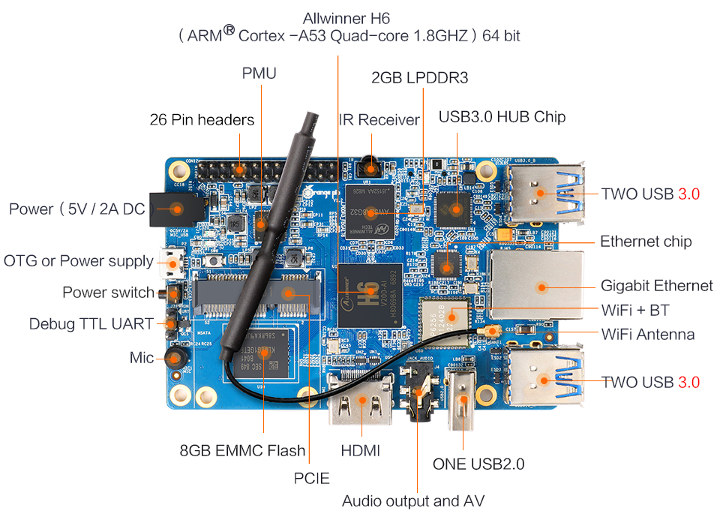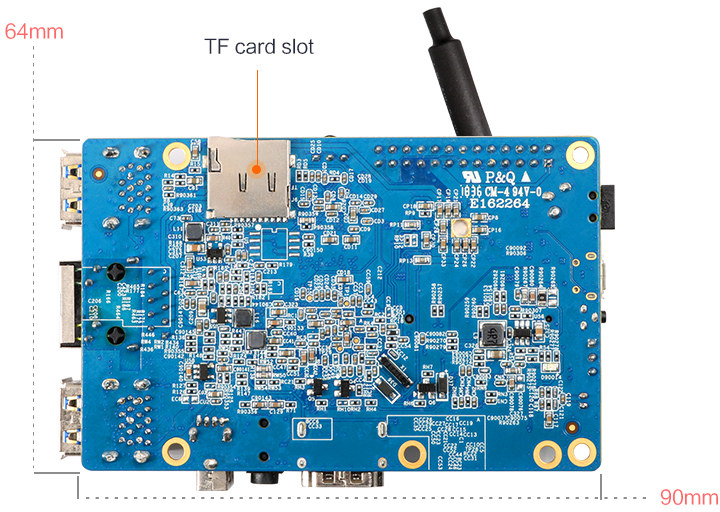Latest SBC Orange Pi 3 H6 - Became Headache for Raspberry Pi (Cheapest Rival)
The Raspberry Pi Foundation launched its updated mini-computer Raspberry Pi 3 Model A+ with built-in Bluetooth and 802.11ac Wi-Fi in November. But what if you are looking for an alternative? In that case, the Orange Pi lineup of SBCs (single board computers) definitely needs to be mentioned.
Just recently, Allwinner A6-based Orange Pi 3 computer has been made available via AliExpress. This full-fledged SBC follows Orange Pi One Plus and Orange Pi Lite2, which were limited to 1GB RAM.
When Shenzhen Xunlong Software launched their first Allwinner H6 development board, Orange Pi One Plus, many were disappointed as the board did not make use of some of the key features of H6 processor like USB 3.0 or PCIe, and RAM was limited to 1GB. A couple of weeks later, the company introduced Orange Pi Lite2 board with 802.11ac WiFi, a USB 3.0 port, HDMI 2.0a output, but no Gigabit Ethernet, nor PCIe interface, and again only 1 GB LPDDR3 memory.
The good news is we now get a full-featured Allwinner H6 SBC thanks to Orange Pi 3 equipped with up to 2GB RAM, an optional 8GB eMMC flash, Gigabit Ethernet, 802.11ac WiFi 5, four USB 3.0 ports, HDMI 2.0a, a mPCIe slot, and more.

There are four variants of the Orange Pi 3 board with either 1 or 2 GB RAM, with or without eMMC flash that share the following specifications:
- SoC – Allwinner H6 V200 quad-core Cortex A53 processor clocked at up to 1.8 GHz with Arm Mali-T720MP2 GPU supporting OpenGL ES 3.1/3.0/2.0/1.1, DirectX 11
- System Memory & Storage options
- 1 GB LPDDR3 + micro SD card slot
- 2 GB LPDDR3 + micro SD card slot
- 1 GB LPDDR3 + 8GB eMMC flash + micro SD card slot
- 2 GB LPDDR3 + 8GB eMMC flash + micro SD card slot
- Video & Audio Output – HDMI 2.0a up to 4K @ 60 Hz, 3.5mm AV jack with composite video and stereo audio
- Audio Input – Built-in microphone
- Video Decoding – 10-bit H.265 up to 4K @ 60 fps / 6K @ 30fps, VP9 and H.264 up to 4K @ 30 fps, AVS+/AVS up to 1080p60
- Networking & Wireless Connectivity
- Gigabit Ethernet via Realtek RTL8211 transceiver
- 802.11b/g/n/ac WiFi 5, and Bluetooth 5.0 via Ampak AP6256 module
- USB – 4x USB 3.0 ports via USB 3.0 hub chip, 1x USB 2.0 host port, 1x micro USB OTG port (also used for power)
- Expansion
- mPCIe socket with x1 Gen2 lane, RC (Root Complex) mode support
- 26-pin header
- Debugging – 3-pin serial console / UART header
- Misc – Power button; IR receiver; power, status, and USB 3.0 LEDs.
- Power Supply – 5V/2A via power barrel jack, or micro USB port; AXP805 PMIC
- Dimensions – 90 x 64 mm
- Weight – 75 grams
The hardware looks good and leverages most features of Allwinner H6 processor, but if you ever plan to use PCIe, be aware that they are issues as explained in linux-sunxi:
The company will release Android 7.0, Ubuntu, and Debian images for the board, which should eventually become available in the download page. Also note that Armbian provides experimental Ubuntu Bionic and Debian Stretch images for Allwinner H6 boards based on Linux 4.19.x, so Orange Pi 3 will likely be added to the list soon.
Pricing for the four variants of Orange Pi 3 board:
- 1GB LPDDR3 – $29.9 + shipping
- 2GB LPDDR3 – $34.9 + shipping
- 1GB LPDDR3 + 8GB eMMC flash – $34.9 + shipping
- 2GB LPDDR3 + 8GB eMMC flash – $39.9 + shipping
You’ll find all four on Aliexpress as usual.
Specs comparison: Orange Pi 3 vs Raspberry Pi 3 Model B+
Please note, this section only compares the listed specs of each board, and should not be taken as a indication of superior performance in practice — particularly given the problems I encountered in testing.
The Orange Pi 3 has a faster processor than the Raspberry Pi 3 Model B+
The Allwinner H6 system-on-a-chip (SoC) used by the Orange Pi 3 relies on a quad-core, Arm Cortex A53-based 1.8GHz CPU.
The Raspberry Pi 3 B+ has a quad-core 1.4GHz Arm Cortex-A53 CPU.
The Orange Pi 3 has similar wireless connectivity to the Raspberry Pi 3 Model B+
The Orange Pi 3 offers the same 802.11ac Wi-Fi but has Bluetooth 5.0, compared to Bluetooth 4.2 on the Raspberry Pi 3 Model B+.
The Orange Pi 3 has faster memory and up to 2x as much as the Raspberry Pi 3 Model B+
The Orange Pi 3 is available with 1/2GB of DDR3 memory, compared to 1GB of DDR2 memory in the Raspberry Pi 3 B+.
The Orange Pi 3 has faster Ethernet than the Raspberry Pi 3 Model B+
Both boards have gigabit Ethernet, but the speed of the Raspberry Pi's Ethernet is constrained by relying on a USB 2.0 bridge, which limits the maximum throughput to about 300Mbps.
The Orange Pi 3 has faster USB ports than the Raspberry Pi 3 Model B+
The Orange Pi 3 has four USB 3.0 ports and one USB 2.0 host, compared to the four USB 2.0 ports on the Raspberry Pi 3 B+.
The Orange PI 3 is available faster storage than the Raspberry Pi 3 Model B+
Alongside microSD card storage, the Orange Pi 3 is available with up to 8GB eMMC storage to the board.
The Orange Pi 3 is slightly bigger than the Raspberry Pi 3 Model B+
The Orange Pi 3 is 93.5mm × 60mm, compared to the Raspberry Pi B+'s 85.6mm × 56.5mm.
The Orange Pi 3 has fewer options for attaching hardware add-ons than the Raspberry Pi 3 Model B+
The Orange Pi 3 only has a 26-pin header for hooking up the machine to other boards, sensors and motors, compared to the 40-pin header on the Raspberry Pi 3 Model B+.
The Orange Pi 3 runs fewer operating systems than the Raspberry Pi 3 Model B+
The Orange Pi 3 supports far fewer open-source operating systems than the Raspberry Pi, listing Android 7.0, Ubuntu 16.04 Desktop, Ubuntu Server, Debian Server Jessie, and Debian Desktop Jessie as being supported.
Orange Pi 3 specs
| CPU | H6 Quad-core 64-bit 1.8GHZ ARM Cortex-A53 |
| GPU | • High-performance multi-core GPU Mali T720• OpenGL ES3.1/3.0/2.0/1.1• Microsoft DirectX 11 FL9_3• ASTC(Adaptive Scalable Texture Compression)• Floating point operation greater than 70 GFLOPS |
| Memory+Onboard Storage | Four Types:1GB LPDDR3 (shared with GPU)+EMMC(Default Empty)2GB LPDDR3(shared with GPU)+EMMC(Default Empty)1GB LPDDR3 (shared with GPU)+8GB EMMC Flash2GB LPDDR3(shared with GPU)+8GB EMMC Flash |
| WIFI+BT | AP6256, IEEE 802.11 a/b/g/n/ac, BT5.0 |
| Onboard Network | 10/100M/1000M , ethernet RJ45 |
| Network Chip | RTL8211 |
| Audio Input | MIC |
| Audio Output | HDMI 2.0a and 3.5 mm AV Jack |
| Video Output | HDMI 2.0a and CVBS |
| Video Decoding | • H265/HEVC Main/Main10 profile@Level5.2 High-tier ;4K@60fps, up to 6Kx4K@30fps• H264/AVC BP/MP/HP@level5.1, MVC, 4K@30fps• VP9,Profile 0/2, 4K@30fps• AVS+/AVS JIZHUN profile@level 6.0, 1080P@60fps |
| PCIE | • Supports RC mode• Supports x1 Gen2(5.0Gbps) lane•Complies with PCI Express Base 2.0 Specification |
| Power Source | DC input,MicroUSB (OTG) |
| PMU | AXP805 |
| USB 2.0 Ports | 1*USB 2.0 Host, 1*USB OTG 2.0 |
| USB 3.0 Ports | 4*USB 3.0 Host |
| Low-level peripherals | 26 Pin |
| GPIO(1x3) pin | UART, ground. |
| LED | Power LED、Status LED and USB3.0 LED |
| IR | YES |
| Key | Power(SW4) |
| Supported OS | Android7.0, Ubuntu, Debian |



Post a Comment